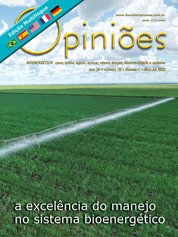Rogério Augusto Bremm Soares
Diretor Agrícola da BP Bunge Bioenergia
OpAA76
A excelência do manejo agrícola no sistema bioenergético
Com papel decisivo para a indústria alimentícia, por meio da produção de açúcar, e de estímulo à diversificação da matriz energética brasileira, com a geração de bioeletricidade e biocombustíveis, o setor sucroenergético enfrenta desafios que demandam cada vez mais a adoção de estratégias capazes de aliar tecnologia e sustentabilidade.
E como uma das maiores processadoras de cana-de-açúcar do mundo, a BP Bunge Bioenergia vem utilizando práticas agrícolas e soluções de gestão do campo que ampliam a produtividade e minimizam os impactos negativos ao meio ambiente. A partir de investimentos em pesquisa e desenvolvimento orientados por uma agenda de valorização da economia circular, garantimos que a sustentabilidade de nossos produtos seja baseada em eficiência operacional com visão de longo prazo.
Nesse sentido, há todo um conjunto de ações que vão desde o incremento do uso de bioinsumos, matérias orgânicas e Mudas Pré-Brotadas (MPB) nas lavouras, até alternativas para reduzir a aplicação de defensivos químicos, qualificar o controle biológico e promover o uso racional da irrigação. Assim, uma iniciativa fundamental passa pela meta de eliminar, no plantio, o uso de fertilizantes minerais até 2025, valorizando a vinhaça e a compostagem na nutrição do solo.
Agricultura regenerativa como diferencial: Aplicada de forma localizada, a vinhaça - um dos subprodutos do processamento da cana-de-açúcar - possibilita evitar o uso de água na irrigação e proteger a qualidade do solo, impedindo a saturação dos campos com potássio. Dos 300 mil hectares próprios da BP Bunge Bioenergia, cerca de 80% já contam com a utilização do resíduo, capaz de expandir a longevidade do canavial em dois anos e trazer ganhos de produtividade entre três e dez toneladas por hectare.
Os resultados são animadores e projetamos até 2025 elevar essa aplicação para 96% das lavouras. Na mesma linha, conseguimos, na safra 2022/23, substituir o uso de fertilizantes nitrogenados em 100% da área de plantio, ampliando a presença da bactéria nitrospirillum amazonense. A solução colabora com a fixação de nitrogênio e o desenvolvimento da cana, incrementando a produtividade nos campos.
Além disso, em 100% das áreas de soqueira é utilizada a bactéria azospirillum brasilense, bioestimulante que inibe estresses nutricionais e doenças e limita impactos climáticos. Tal prática já oportunizou, por exemplo, a diminuição de 50% das doses de nitrogênio.
Presente no DNA da BP Bunge Bioenergia, a agricultura regenerativa conta com diversas técnicas que protegem a saúde e a fertilidade do solo e favorecem a biodiversidade. Entre elas está a compostagem, pela qual podemos melhorar a condição do solo e ter um aumento de produtividade entre 10 a 15 toneladas por hectare.
Desse modo, no último ano safra começamos a padronização dos pátios de compostagem para mistura de torta de filtro (oriunda da filtração do caldo da cana) e das cinzas do bagaço (derivadas da queima para geração de bioenergia) - até 2025, a meta é produzir fertilizantes organominerais a partir dessas matérias orgânicas e eliminar, no plantio, o uso de fertilizantes minerais, como o fósforo e o potássio.
Bom para o setor, melhor para o meio ambiente: Outro eixo significativo na busca pela excelência no manejo agrícola é o controle biológico de pragas. Nas nossas 11 usinas, utilizamos drones/VANTs, entre outras tecnologias, para fazer a distribuição das larvas da vespa cotesia flavipes nos canaviais, visando o combate da broca (larva que causa grandes perdas de produtividade nas lavouras).
Já no enfrentamento à cigarrinha e ao sphenophorus levis (bicudo da cana-de-açúcar), a empresa utiliza, respectivamente, o fungo metarhizium anisopliae e a tecnologia dos nematoides entomopatogênicos (heterorhabditis bacteriophora), onde ela é pioneira e conta com ótimos resultados.
No intuito de potencializar a produtividade nos canaviais, se mostra muito efetivo o plantio com Mudas Pré-Brotadas (MPB), importantes para garantir rastreabilidade e reduzir custos. No Núcleo de Produção de MPB - unidade Moema, em Orindiúva-SP, geramos por volta de 3,4 milhões de mudas de cana-de-açúcar ao ano, levando em conta as especificidades de cada uma das 11 unidades da companhia.
Esse processo alavanca a confiança na origem do material e proporciona plantas mais saudáveis e de crescimento 20% mais veloz em comparação a outros métodos de plantio.
Por fim, cabe salientar que a redução na captação e no consumo de água e a qualidade dos recursos hídricos fazem parte da nossa agenda sustentável, presentes nas metas de “Nossos Compromissos 2030”, que tem a finalidade de garantir o uso racional desse recurso em nossos processos agroindustriais.
Tanto para amenizar impactos climáticos como para maximizar a produtividade nos campos, nosso manejo de mitigação de déficit hídrico foca na organização da colheita e na expansão consciente de irrigação e fertirrigação (sem vinhaça localizada), auxiliando na brotação e melhora do ciclo produtivo. Na última safra (22/23) a aplicação de água ou vinhaça alcançou aproximadamente 60% da área plantada.
Além do manejo de colheita e da irrigação, outras práticas são utilizadas constantemente para promover o crescimento das raízes, como, por exemplo, incorporação de matéria orgânica, rotação de cultura, aplicação de adubo organomimeral e estimuladores de desenvolvimento. Importante destacar que o aproveitamento da água residuária e da vinhaça no processo de fertirrigação permite que também tenhamos menor demanda de captação de água nos cursos d’água, para fins de irrigação.
Alcançar elevados índices de produtividade, em consonância com um projeto de desenvolvimento sustentável, exige empenho, investimentos, pesquisa, tecnologia. Exige avançar em melhores práticas, em eficiência e identificar oportunidades.
Nosso compromisso em ser a referência mundial na produção de energia sustentável passa por algumas das técnicas brevemente destacadas neste espaço, e que deverão ganhar ainda mais força nas próximas safras, objetivando construir um futuro de baixo carbono com a economia de recursos financeiros e ambientais.




